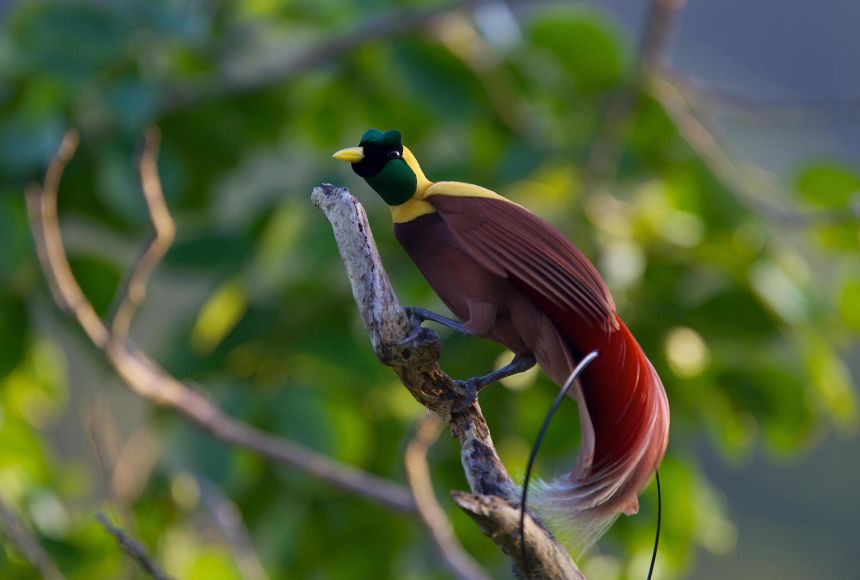High above the rainforests of Papua New Guinea, male red birds-of-paradise gather to display. They look resplendent in the morning sun: primary-colored and sleek, with fine, black tail feathers that coil behind them in ribbons. It’s easy to see why early explorers mistook these birds for mythical creatures. They let out a repetitive, piercing screech to advertise their presence. A cacophony of disorganized sound erupts from the treetops as each bird’s call competes with the next. When a female finally appears, the males begin bobbing and strutting, fanning their delicate wing feathers, each trying to secure the females attention for himself.
With their dramatic appearance and eccentric courtship behavior, it’s no wonder birds-of-paradise have captured people’s curiosity for so long. They were first introduced to the Western world in the early 16th century, when Magellan’s crew brought specimens back from the East Indies. Since then they have been inspiration for paintings, poetry, and women’s fashion.
Birds-of-paradise can be found throughout Papua New Guinea, the surrounding Indonesian islands, and a small part of northeastern Australia. There are 39 species altogether, each one different from the next. They come in a dizzying array of colors, shapes, and sizes, from the plain-looking paradise-crow to the flamboyant plumage of the Raggiana bird-of-paradise. These birds are certainly magnificent to look at, but they are perhaps best known for their ostentatious courtship displays.
With a flick of his blacker-than-black cape feathers, the male Superb bird-of-paradise shape-shifts into a barely recognizable form–endearingly dubbed the “psychedelic smiley face.” A frantic, twitching blur of feathers, he hops this way and that, making sure the female is always getting his best angle. He whirrs and clicks and snaps his tail rhythmically, flashing a breastplate of iridescent feathers in a game of now-you-see-me, now-you-don’t. The female looks on impassively.
His dance moves may appear erratic, but they are carefully choreographed to convince females that he is the best mate. The male bird-of-paradise works hard to impress, tirelessly refining his moves until the female is suitably enthralled. It is the males that are known for their extravagant plumage and twerking tendencies. The females are quite ordinary by comparison, but the females are also the ones in charge, making the decisions.
Impressive as it is, the male’s beauty is impractical. Take the ribbon-tailed Astrapia for example. This bird-of-paradise boasts bright white tail feathers a meter (three feet) in length. Excessively long tail feathers might be great for attracting mates, but they aren’t exactly useful for survival. In fact, it’s easy to see how they might be a hindrance. So how did these features evolve? The answer lies in the theory of sexual selection.
According to Darwin’s theory of natural selection, traits evolve and become more common in a population if they improve an individual’s ability to survive. But the Astrapia’s bright long tail feathers don’t seem to confer any kind of survival advantage, and in fact they may hinder survival by complicating the Astrapia’s ability to hide from predators.
It’s one thing to have a trait that improves your likelihood of survival, but if you can’t find a mate, you can’t pass the trait on to the next generation. To account for this, Darwin’s theory of sexual selection suggests that traits can also evolve in a population if they improve an individual’s ability to attract more or better mates, even if those same traits are a detriment to survival in the long term. If natural selection explains evolution driven by the competition for survival, then sexual selection explains evolution driven by the competition for mates.
The dense jungles of Papua New Guinea provide a bounty of nutritious food for the birds-of-paradise. What’s more, it’s an island with very few natural predators. These are the perfect conditions for a specific type of sexual selection, known as “female choice,” to arise.
When resources are plentiful and there are few predators, females don’t need the males to defend them, provide food, or help raise young. They can be picky when it comes to choosing a mate and require the males to work hard to impress the females if they want the chance to mate and pass on their genes.
Every now and again, due to genetic processes of recombination and mutation, new traits emerge in a population that females find more attractive. For example, one year in a population of crow-like birds, a male may be born with longer-than-average feathers. For whatever reason, a female finds long feathers more attractive than short feathers and the two birds mate. Their young inherit both their father’s feathers and their mother’s preference. Over successive generations, these traits become more and more prevalent in the population. In other words, the preferences of the females are literally shaping the appearance of the males over time.
The male birds-of-paradise are certainly a sight to behold, but there is more to their performance than first meets the eye: When you look at a bird-of-paradise, you are witnessing evolution in action. And, while the male grabs our attention, strutting and preening center stage, it’s easy to forget that it was generations of discerning females that shaped the incredible appearance and outlandish courtship behavior that gave birds-of-paradise their name.

